Spectacle society, 2019















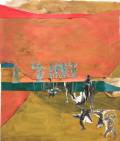
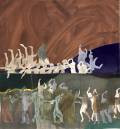

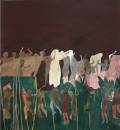
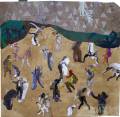
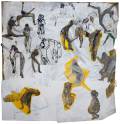
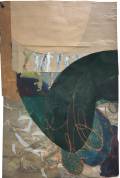
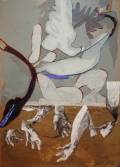
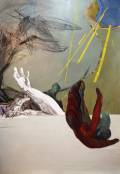

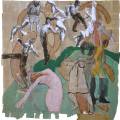
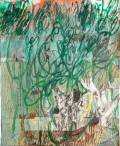
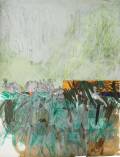
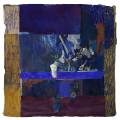
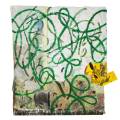
Continuing the modus operandi begun in the series Liquid Societies (2017), we present a body of work made up of works on paper where painting and drawing coexist.
The trigger remains in events, more or less collective, that reach us through the media or, alternatively, are reflected in small everyday events that seem to refer to these same broader and more complex issues.
The process of apprehending this triggering of the work is neither linear nor clearly recognized. Unexpected associations are created between films, song lyrics, colors, patterns and word games that create mental collages of post-its scribbled at different times and in different situations, with different scratching materials, some invisible or marking in the negative, often generating indecipherable marks; there are others where the meaning is found in the absence of the mark, in what was not meant or written down, in the void.
A vocabulary of visual references is created, symbols that are played with – in the works presented here, it was the dancing figures – and others (pigs, yellow dogs, triangles) that reappear just as we still write, with pleasure, object or actuality with C. Here, just as in spelling, it is not possible to break our habit and the desire to communicate is greater than that of correctness. DaVinci said that when writing the most beautiful poems, the poet’s handwriting doesn’t matter.
The modus operandi (the one that is maintained) is based on the impotence of maintaining one. There are no physical or mental drafts or sketches, and the process is a continuous groping in the dark where we use these symbols to find meaning. However, this is not linear and we stagger back and forth in each ambition of the work until we give up at a moment when, exhausted, we get used to the darkness and glimpse something. By this we mean that each work is the result of an unplanned and aimless process, arrived at by chance. We start in an organized way – the trigger is clear and the vocabulary to be used is obvious to us – but from the clarity of the composition we feel suspicious, a sense of dishonesty. If our ideas were so clear, so organized and so verbalizable, the process of drawing would be redundant. We don’t identify at all with the process of making real works that are nothing more than the treatment of sketches.
For us, it only makes sense to dedicate ourselves to work that is, until we give up, a creative process (we say this not because we think it’s good, but because we understand that it has been).
Like the realist (in Brecht’s sense), we believe that all means are valid to get closer to the truth. However, like the postmodernist (in the sense of Lyotard or Rorty), we also believe that there is no such truth. How beautiful is this expanded space in which anything goes so that we can express ourselves, free from the presumption of transmitting truth, free from fashions and prejudices and fears of regression, reference, illustration or narration?
Here, we separate drawing from painting, praising the former which, in its broadest sense, is pure freedom. The latter, which can have color, texture, three-dimensionality, gradation, noise, separates itself from the nature of painting because it is always an act of freedom, directly connected to thought and body, to gesture, in such rapid communication that translation errors are inevitable and in these errors we find what is most original and true.
These works live off making mistakes and deliberately creating chaos. There is no greater feeling of detachment than the one you get from ruining something that seemed finished and secure. Fortunately, out of this instability, other things are built, on which we naturally lay better foundations. This process repeats itself. Then you stop. You photograph the results and call it a day: you give it a title, date and signature. Sometimes you put it aside to frame it. But often we come back, almost nauseated by something that needs to be corrected for some reason, and then we start again.
The various stages of the process, the various “I’s” of each work, are not photographed. If they are, it’s only because, in fact, they thought they had reached the end at other times. This is important because it clarifies that none of this is performance. None of this is a spectacle. When it is, everything will be ruined.
Is the trigger important? Yes, but not for the work. It’s something of ours that, for some reason, we feel the need to mark. Perhaps this is our small way of paying attention to such a theme, perhaps homage?…we don’t like the term or the idea, but perhaps it is: homage in our language which, although not literal, is probably only understood by us. Sometimes it’s a denunciation, but neither the public nor the honoree, neither authority nor the Holy Spirit receive it. Perhaps in this way we’ll be able to abolish the pyrrhicism we feared and we’ll be able to accept our weakness for romantically sending letters without a destination.
Dissecting the incomprehensible through form…the figure: it has remained a transversally present symbol, whether in its total or partial form, based on a natural referent or photograph. Sometimes it is transformed and takes on an animal shape or form; other times it is mutilated or misshapen; sometimes it appears as a stain that is only human in its relationship with the other signs that make up the work. In the works presented here, some dance the twist, alienated, were this not a contemporary dance of Guy Debord’s writings – the pinnacle of the show. Others, more restrained, are amazons – an easy association when, backstage, we think of the fires of Brazil, pretexts for the figure. Dogs and pigs are brought in by Orwell; before that, goats were a constant (not only do we have them available to land on, but they are, in fact, exciting forms to represent with their coats and rough movements, shapely legs and alien gaze… were it not for their useless symbolism and they would, in my opinion, be side by side with the female body as one of the most curious forms to represent!) Fragments of statues and limbs of bodies are icons that flee, stumble and sink. The triangles are tents, camps in the image of old Afghan maps. The plant shapes and greens are references to the burning Amazon but also to the Calais Jungle and the wildness of men, the author’s context, the countryside.
These are references glued together with spit, paperclips and staples; everything else is a mistake and an accident.
Next steps? We confess we’ve already taken some, but we’d rather not present them just yet. On the one hand, we’re going down a slightly more abstract path, starting with the triangles that appear here; on the other hand, there are trained monkeys who bang cymbals and play drums disconcertingly side by side with figures, or parts of them, between the monkey and the human, creating noise, the noise of the show. In either case, the process continues and so these paths await their destruction and reformulation while they pick up the marks of that wait, resulting from accidents, carelessness and dirt.
In the studio we create chaos: we avoid tidying up, cleaning up. The entrance is open to almost everyone, and recently dogs and cats have been accepted, as they break down any remnants of organization.
We recognize that our choices always border on implosion: if a theoretical-practical dissertation has enormous difficulties, imagine one in which the practical component is related to the work of several authors. However, this is in line with our practical process, which is also unstable and made up of small implosions, creating debris, shrapnel. However, we believe in the objectives set for this research and we don’t know how to work any other way: a continuous nervousness, with weight and measure, seems necessary (the cardiologist warns us, now that prenatal care obliges us to be under constant medical observation, that our heart rate is exaggeratedly high; now, and although we have drastically cut back on caffeine, this also seems to be a necessary condition for our activity, just as the opposite happens to those who run professionally).
The personal begins to emerge and it may be time to call it a day. We’ve never done it like this, maybe we got too carried away… which seems like a good sign to us. Now let’s reread and perhaps conclude something. We’ll take a walk outside and come back.
This could have been yet another aimless letter or notebook entry that, we confess, we never read again: once again we are interested in the doing, it is in this that we find pleasure, and not in the telling. Nevertheless, these lines go to Simão Bolivar, who has so kindly taken the time to read them and, we hope, with a more sensible heartbeat, will try to find some juice in this ugly fruit. We hope, here and in the work, to be able to gather enough juice to quench the thirst of the demands of this project – because we know that skill and culture are lacking in those who hand over the material.
If these were other times, this would be a beautiful letter (although probably less legible because, in the eagerness to write and as DaVinci said, there goes the handwriting). In 2020 and with covid, here goes this text in Word…
Extract from “Sumo de Fruta Feia”, a letter to Simão Bolívar, 2020.